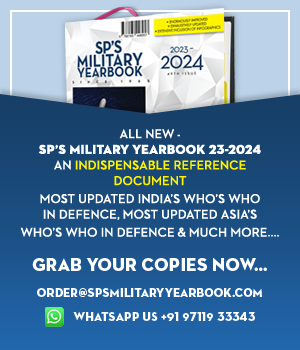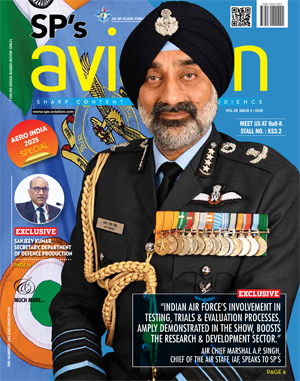INDIAN ARMED FORCES CHIEFS ON OUR RELENTLESS AND FOCUSED PUBLISHING EFFORTS
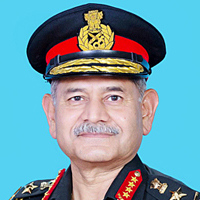
The insightful articles, inspiring narrations and analytical perspectives presented by the Editorial Team, establish an alluring connect with the reader. My compliments and best wishes to SP Guide Publications.
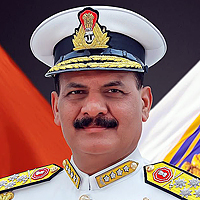
"Over the past 60 years, the growth of SP Guide Publications has mirrored the rising stature of Indian Navy. Its well-researched and informative magazines on Defence and Aerospace sector have served to shape an educated opinion of our military personnel, policy makers and the public alike. I wish SP's Publication team continued success, fair winds and following seas in all future endeavour!"

Since, its inception in 1964, SP Guide Publications has consistently demonstrated commitment to high-quality journalism in the aerospace and defence sectors, earning a well-deserved reputation as Asia's largest media house in this domain. I wish SP Guide Publications continued success in its pursuit of excellence.
Lessons for Airpower
Learning from the Past and Ongoing Conflicts

After 1,000 days of closely watching the Russia Ukraine conflict, there are probably half that number of articles analysing the lessons of the operations. Strategists, think tanks and military leaders look at it from the political, strategic, operational and tactical levels and no matter which way you look at it, there will always be contrasting views.
THE NEW AGE TECHNOLOGIES
Tacticians have dissected the efficacy of kamikaze drones, the logisticians have analysed the failure of supply chains to keep the armour rolling and the image analysts have examined the bomb damage. New age tech geeks have looked at the 4th gen and 5th gen technologies, particularly those involved in battlefield communications. Journalists have questioned the political motives, alliances and fall outs. Economists debate the effectiveness of sanctions and the oil prices.
New age technologies will always remain at the forefront of any commentary on conflicts. The first Gulf War will always be remembered for the targeting strategies and use of precision weapons along with cruise missiles and stealth platforms. It was indeed the beginning of “Revolution in Military Affairs”. But the new technologies of long-range communication and use of GPS for navigation and precision strikes caught everyone’s attention and became a part of the ‘must have’ procurement plans of all militaries. Simplistic Command and Control became C4ISR. The development of newer microchips and enhanced computational power gave rise to integration of myriad systems multiplying their individual capabilities.
AIR POWER IN MODERN INTERVENTIONS
The NATO intervention in Kosovo (Operation Allied Force) had built on the lessons of the Gulf War and introduced new dimensions of air power application. Air power was used to enforce no-fly zones and strike Serbian military targets without a largescale ground invasion. Air strikes forced Yugoslav President Slobodan Milošević to withdraw his forces from Kosovo and agree to NATO’s terms, ending the conflict without the need for a ground invasion This reflected a growing belief in air power as a primary tool for limited military interventions.
The US interventions in Afghanistan (2001-2019) and Iraq (2003-2011) further evolved the role of air power in modern warfare. With insurgencies being the primary threat in both wars, air power adapted to provide close air support to ground forces in counterinsurgency operations. The use of drones and fixed-wing aircraft for precision strikes on high-value targets became crucial. UAVs like the MQ-1 Predator and MQ-9 Reaper transformed air power by providing persistent surveillance and strike capabilities. Drones became a tool for both ISR and targeted killings, allowing for precision strikes with minimised risk to human pilots.
In both Afghanistan and Iraq, the urban environment presented significant challenges for air power. The need to distinguish combatants from civilians in crowded cities made airstrikes more difficult, emphasising the importance of precision targeting and minimising collateral damage. The accidental bombing of civilian targets during the Kosovo campaign (1999), including the Chinese embassy in Belgrade, illustrated the political and strategic challenges air forces face in avoiding collateral damage and managing public perception.
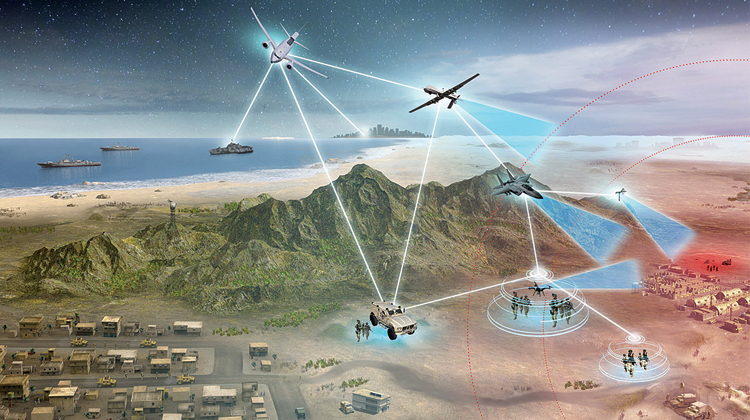
The NATO intervention in Libya (2011) provided new insights into the use of air power in regime-change operations without committing significant ground forces. NATO relied heavily on air power to degrade Libyan military capabilities and support rebel forces on the ground. This model emphasised using air power to tip the balance in a civil conflict. The Libya conflict showed how air power could be applied in low-intensity campaigns with fewer resources compared to major wars like Iraq or Afghanistan, reinforcing the idea that air power could have strategic effects even without large-scale military engagement.
The Syrian conflict (2011- 2024) has been a complex battleground for air power, involving multiple state and non-state actors with competing objectives. Russia’s intervention in 2015 demonstrated a different approach to air campaigns, characterised by high-intensity airstrikes on rebel-held areas. Russian air power was decisive in tipping the balance in favour of the Assad regime, showing how air power can be used to support friendly ground forces in a civil war. The Syrian conflict also saw the rise of anti-drone and anti-aircraft systems. The proliferation of man-portable air defence systems (MANPADS) among insurgent groups posed a significant threat to low-flying aircraft and drones. Meanwhile the US conducted a limited air campaign against ISIS in Syria (and Iraq) under Operation Inherent Resolve. This demonstrated the ability to apply air power selectively against non-state actors while avoiding deeper involvement in the conflict.
SYNERGY OF DOCTRINES AND TECHNOLOGY
In the last two decades, new terms began entering our lexicon. “System of systems” thinking implied synergistic application of improved technologies ranging from electronic counter measures, data links, stealth, embedded microprocessors and advanced sensors. Since then, ‘battlefield transparency’ through near real-time information updates became an integral part of any commander’s ops room. A common operating picture was considered essential for decision making.
In the years before the Gulf war, American analysts had convinced the generals that forces with the most advanced or best individual systems may not fare well against forces that have better information and greater ability to plan coordinate and attack accurately. The US and its allies had focussed on not only improving situational awareness, but maintaining information superiority through gaining deep knowledge of the adversaries, nature of the potential threats and use of advances sensors. It is essential that this is not confused with mere technological capability to produce a common operating picture. When the ongoing conflicts are seen through this prism, what emerges is the question, ‘did the Russians and the Ukrainians have a ‘common operating picture’? If so, were there shortfalls in data collection, or data analysis? Was it due to inadequate sensors or lack of AI supported decision making? Or was it lack of training and exposure to high tech systems of the senior leadership?
Drones have redefined modern warfare, particularly as reconnaissance assets, yet they face challenges against layered air defences, with Russia effectively using drones for targeting up to 120 km behind the front line
While the US and its allies were building up their post war forces based on the lessons of the Gulf war and the conflicts in Kosovo, Syria, Afghanistan, Libya and Iraq, Russia and China began focusing on Anti-access, Area Denial(A2AD) capabilities, based on their own analysis of these campaigns. In the post-Soviet period, a line of Russian military thinking had increasingly played down the centrality of kinetic violence to war. Nonkinetic forms of influence, particularly information influence, had increasingly been interpreted as means of war by Russians. Ideas about a ‘new war’ had been growing in importance in Russian military and security circles in the years prior to the conflict. This thinking had been generated by top Russian military officers and it emphasised the effectiveness of non-kinetic measures, long-range precision strikes and limited elite force deployment, whilst downplaying the likelihood of large-scale conventional war. After the break-up of the Soviet Union, armed conflicts erupted in Tajikistan, Moldova and Chechnya. High readiness, small units were deployed to quell the violence and their successes strengthened their views on new age conflicts. Russian strategists and senior military officers propagated the importance of information warfare and covert actions and subversion. Its limited action in Syria further cemented this line of thinking.
The initial phase of the present conflict saw kinetic action centred around the use of special ops forces, airborne forces and long-range strikes. The scant logistical support provided to the frontline units along with the tactics of the motorised forces were evidence of this operational plan. While we analyse the final outcomes of this conflict, we will have to weigh the gains and losses against the intellectual merit of the Russian doctrines.
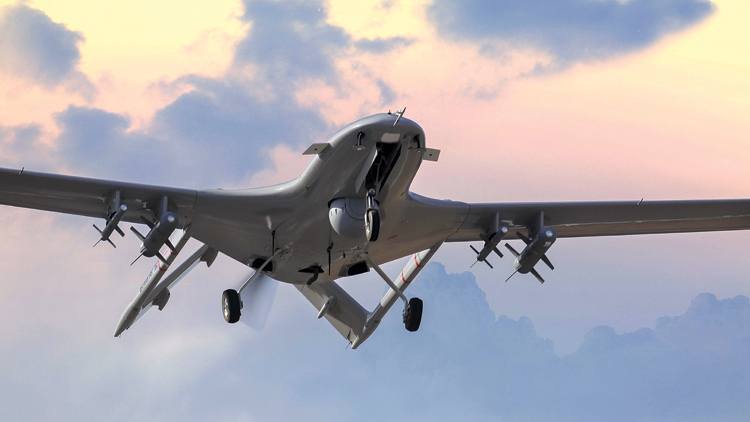
There have been significant advances in technology, doctrine, and strategy from the early 90s to the present-day conflicts. Each conflict has added or subtracted a dimension of air power and also provided valuable lessons and shaped modern air power. In many cases, air power has not only altered the course of wars but has also proven decisive in achieving strategic or tactical victories. From World War II to the Gulf War and the modern conflicts in Kosovo, Libya, and Nagorno-Karabakh, air superiority, precision strikes, and strategic bombing campaigns have been critical in shaping the outcomes of wars. Advances in technology, including drones and precision-guided munitions, have further solidified the role of air power as a decisive force in contemporary conflicts.
HOW CONTEMPORARY CONFLICTS INFLUENCED AIR POWER
Against this backdrop of contrasting doctrines and strategies, it is essential that we look at the major tactical lessons of the conflicts of the 90’s and see how both sides devised their operational plans. This article will focus primarily on the air power aspects and how these were influenced by past conflicts.
The Gulf War (1990-1991) is often considered a turning point in modern air power due to the successful execution of a large-scale air campaign. Some key lessons and developments were the use of Precision-Guided Munitions (PGMs) and the importance of SEAD ops. The Gulf War was a showcase for the effectiveness of PGMs, such as laser-guided bombs. They significantly increased the accuracy of air strikes, allowing for targeted destruction with reduced collateral damage. In the ongoing conflict, the Ukrainians could strike some critical targets and even target top Russian leadership through precision air strikes. Ukraine received more than 300 Storm Shadow and SCALP cruise missiles from European allies and were quick to integrate these on the MiG-29 fighters. Their long-range strike campaign was based on targeting Russian C2 and logistics centers, but these did not have much impact as these strikes never reached the critical level of damage that would disrupt the C2 or logistics systems. The strikes themselves were not effectively synchronised with ground operations that would have halted the Russian offensive. The next priority of the precision strike campaign was to destroy the Russian Black Sea Fleet and to degrade defences on the Crimean Peninsula. In the initial analysis it has been seen that those strikes using Storm Shadow/Scalp in support of the ground operation proved less successful than striking naval targets, where the damage caused was absolute and irreversible.
New-age conflicts increasingly leverage ‘system of systems’ thinking, combining electronic countermeasures, data links, stealth, advanced sensors, and real-time information updates to enhance battlefield transparency
Militarily, the targets are easy to determine. Destroying Russia’s ammunition dumps, or the fuelling and arming points for its attack helicopters, or Russian tactical-operational missile complexes, would have a useful effect in reducing the casualties being suffered by the Ukrainians. But the targets that will yield leverage in negotiations will primarily be economic and industrial. These would be depth and ideally suited for air force strikes. In this case, the Ukrainians were probably constrained from using NATO supplied weapons for the fear of escalating the conflict.
The impact of precision strike was further mitigated by Russian countermeasures. The munitions that were to deliver these precision effects had been employed for almost a year by the time the offensive began. Whereas Excalibur, for example, was achieving around 70 per cent effectiveness at the beginning of the conflict, by August 2023, it was hitting the designated point only six per cent of the time, a rate lower than non-precision munitions. This was because of exquisite electronic warfare (EW) countermeasures fielded by the Russians.
On the other hand, Russian forces conducted a series of missile and drone strikes of varying sizes, using various combinations of drones, cruise missiles, and ballistic missiles with primary targets being the powerplants, and energy distribution sites. Russian missile attacks had roughly 50 per cent interception rate during the three large-scale Russian missile strikes against Ukrainian energy infrastructure. The increased effectiveness of Russian strikes as the days went by, was not only a result from the accuracy of missiles and drones used in the strikes, but also due to their exploitation of the degradation of Ukraine’s air defence umbrella. While Ukrainian AD systems were being bolstered by redeployment of NATO systems, the Russians made use of the window to conserve their precision munitions and use more of their heavy calibre conventional bombs.
TACTICAL LESSONS AND FUTURE DIRECTIONS
Modern air operations, particularly in contested environments like Syria, faced significant challenges from advanced air defence systems. This led to an increased focus on SEAD and electronic warfare. The Russians and Ukrainians had to seek out of the box approaches as conventional SEAD was unlikely to be effective and they needed to think of better alternatives to carry out SEAD. Ground forces were given primary tasks of DEAD using organic firepower. Drones swarming AD, kamikaze drones for DEAD and for carrying out soft kill, were no more fictional concepts.
The Gulf War had highlighted the value of real-time intelligence. Platforms like AWACS (Airborne Warning and Control System) and JSTARS (Joint Surveillance Target Attack Radar System) played a critical role in battlefield awareness and target acquisition. Russia could find targets that were dispersed over a very large battlespace, by increasing the number of sensors networked to its conventional and rocket artillery so that they could receive coordinates directly from UAVs or artillery locating radars. In addition, loitering munitions particularly of the Lancet family were being used in large numbers by Russia.
Drones have occupied a considerable space within the field of defence especially as reconnaissance assets since the extensive use of the Bayraktar TB2 in the 2020 Nagorno-Karabakh war. That conflict demonstrated the apparent supremacy of drones and the ease with which they can alter a battle. However, the same TB2s were relatively powerless against Russia’s layered air defences. Russia used a plethora of drones for recce and strikes, but the most effective use of drones was for providing targeting up to 120 km behind the front line for Iskander short-range ballistic missiles.
A major lesson learnt from all the conflicts of this century was that, without careful frequency management, forces are liable to engage in widespread fratricide in the EM spectrum, including degrading the efficiency and survivability of own UAVs. Russian forces were able to update their frequencies every 24 hours, deconflicting UAV orbits. Added to this was their ability to synchronise EW with manoeuvre, particularly with their ground forces. It has been observed that the Russians had delegated the management of EW capabilities to include counter measures, to the battalion level, while the Ukrainians had delegated it to a higher level. Ukraine found that with their UAVs, a rapid refresh rate of both software and radios was necessary to maintain their effectiveness.
Modern software-defined systems require sufficiently large bandwidths to avoid broad-band jamming, and yet need to have enough spectrum available for the range of systems that are being operated by all the services. Centralised allocation of frequency bands may not be the appropriate solution. Flexibility in the use of spectrum and adaptability to constantly changing ELINT inputs will be the key to success. This is going to become the most important factor in joint planning and needs to take into account the spectrum requirements for civilian usage, mobile communications and limitations of back-up systems. In order to maintain the technological and qualitative edge it may be prudent to equip our systems with hardware that can be replaced at the field level. This can be supplemented by providing the ability to re-programme the radios and data links at unit levels based upon the ELINT inputs.
Analysis of all elements of air power like helicopter ops, combat support ops, fighter strikes and air transport ops would reveal that in the new age wars, dominance over Space, Cyber and EM domains will remain key to success. The characteristics of air power need to be harnessed using the latest tech and innovative tactics. Flexibility, mobility, concentration of force, shock effect, offensive action, and responsiveness can be harnessed for suitable response options in almost all scenarios that we may be faced with. Air power has altered the course of several wars throughout the 20th and 21st centuries by providing strategic advantages, tipping the balance in favour of one side, and even ending conflicts.
CONCLUDING INSIGHTS
Atmanirbharta or self-reliance, especially in weapons will remain a key take away. While many nations gifted Ukraine a significant proportion of their weapons, even at the cost of depleting their own national stocks, this did not amount to a sufficient volume of equipment required. In order for any concept of operations to be executed, a certain minimum number of critical enablers/weapons are required for the planners. A shorter development-integration-deployment cycle has to be created to retain the edge over any adversary.
Drawing an analogy between conflicts or listing out the lessons is never a straightforward exercise. The differences between conflicts will always dwarf the similarities, particularly when historical, geographical and political differences exist. Military leaders should not get trapped in contracted comparisons as they may lead to false expectations. Comparisons and analysis of outcomes can be useful for policy formation when made judiciously. The current war in Ukraine, may offer clear tactical and strategic insights while raising important questions about planning, support, and operations.
As they say, learn from other’s mistakes, don’t insist on making your own!
The author retired as Chief of the Air Staff, Indian Air Force on September 30, 2024.




